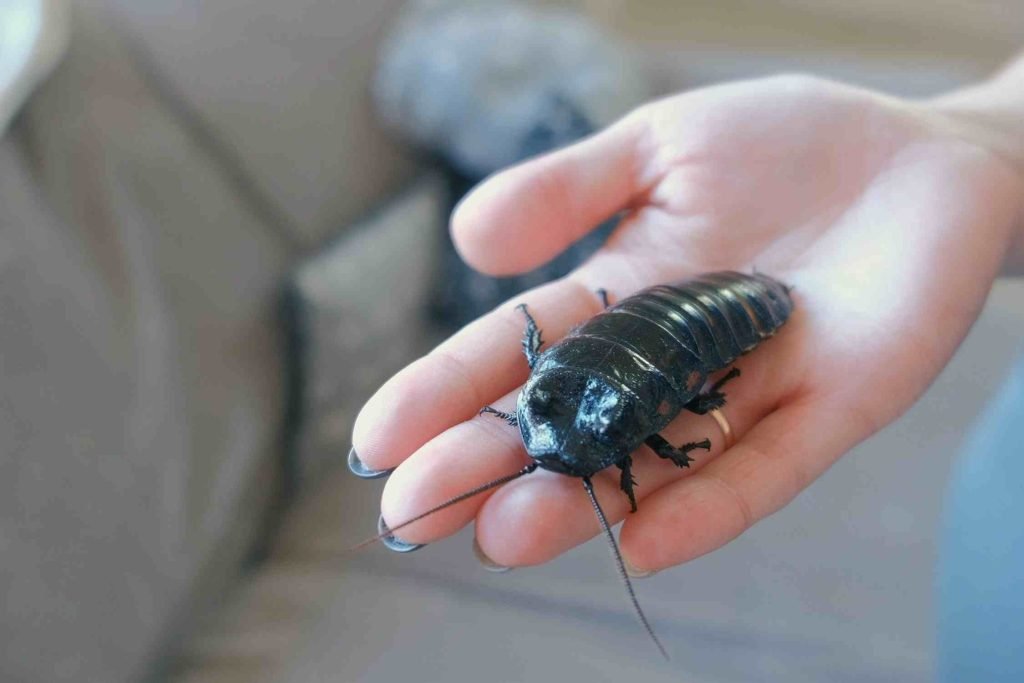Exotic
Why Madagascar Hissing Cockroaches Make Fascinating and Unusual Pets
In the world of exotic pets, one surprising creature has been making a name for itself: the Madagascar hissing cockroach. While roaches might not be everyone’s first choice as a pet, these fascinating insects are increasingly popular due to their unique characteristics and low-maintenance care requirements.
What is a Madagascar Hissing Cockroach?
The Madagascar hissing cockroach (Gromphadorhina portentosa) also known as a ‘hisser’ is native to the island of Madagascar off the coast of Africa. It’s one of the largest species of cockroach, reaching up to 3 inches in length. Named for the hissing sound they produce when threatened, these insects are actually quite docile and harmless.
Not only are they unable to bite or sting, but unlike many other roach species, they also can’t fly or climb smooth surfaces. This makes them easy to contain, reducing the chance of escape that may be a concern with other types of exotic pets.

How to Keep a Madagascar Hissing Cockroach as a Pet
First, it’s important to ensure you’re following all local laws and regulations regarding exotic pet ownership. In the U.S., it’s generally legal to own Madagascar hissing cockroaches, as long as you adhere to your state’s specific rules.
When it comes to housing your new pet, a simple, well-ventilated terrarium or glass tank will suffice. A dark, moist, and secluded area within the enclosure is essential, as these insects prefer to hide during the day and become more active at night.
Benefits and Advantages of Owning a Madagascar Hissing Cockroach
Despite their somewhat intimidating appearance, Madagascar hissing cockroaches make excellent pets, particularly for children. They’re clean, low-maintenance, and entirely harmless. The care and upkeep for these insects are minimal, which can be a great introduction to pet ownership responsibilities for kids.
Additionally, they provide an opportunity to learn about a unique species and its behaviors. Observing these creatures can be a fascinating experience, making them not just pets, but also a source of education and entertainment.
The Madagascar hissing cockroach may not be the traditional choice for a pet, but it offers a unique and engaging pet ownership experience. Whether you’re a seasoned exotic pet owner or just starting your journey, this docile, easy-to-care-for insect might just be the perfect addition to your home.
What do They Eat?

Madagascar hissing cockroaches are omnivorous, which means they eat both plant and animal matter. Their diet in the wild largely consists of fallen fruit and decaying plant material, but they will also consume animal matter when it is available.
As pets, Madagascar hissing cockroaches can be fed a variety of fruits and vegetables, such as apples, bananas, carrots, and lettuce. They also benefit from protein sources like fish flakes or dry cat food. Do note, however, that they should not be fed citrus fruits, as these can be harmful to them.
Providing them with a piece of hardwood or a cardboard egg carton can also be beneficial, as they will eat and burrow into these materials, mimicking their natural behaviors in the wild.
Remember to always provide fresh water for your pet cockroach. This can be done through a shallow dish, or by providing fresh fruits and vegetables, which have a high water content.
Overall, while their dietary needs are simple, it’s important to provide a varied diet to ensure they receive all the necessary nutrients.
Ideal Habitat for Your Pet Roach

Creating the ideal habitat for a Madagascar hissing cockroach involves a few key elements:
1. Housing: A glass or plastic tank that’s at least 5-10 gallons in size is suitable for housing these roaches. They need space to move around and explore.
2. Substrate: A layer of substrate, such as coconut fiber or peat moss, should be provided on the floor of the tank for burrowing.
3. Hiding Spots: Provide plenty of hiding spots using items like cork bark, cardboard egg cartons, or small logs. These roaches are nocturnal and prefer to hide during the day.
4. Humidity and Temperature: Madagascar hissing cockroaches thrive in humid environments. Maintain a humidity level of about 60-70% by misting the enclosure regularly. They also need a warm environment, ideally between 75-90°F (24-32°C). A heating pad can help maintain the right temperature.
5. Food and Water: Fresh fruits and vegetables should be provided, along with a protein source. Avoid citrus fruits. Fresh water should always be available.
6. Cleaning: Regular cleaning is important to prevent the build-up of waste and uneaten food. This will help prevent issues with mold and mites.
Remember, each pet is an individual and may have specific needs. Always monitor your pet’s behavior and adjust the habitat as needed. It’s also recommended to consult with a vet or a pet care expert if you’re unsure.
Tips to Keep Your Pet Roach Healthy
Keeping your Madagascar hissing cockroach healthy involves a few key steps:
1. Balanced Diet: Ensure they are eating a balanced diet of fruits, vegetables, and protein sources. Avoid citrus fruits as these can be harmful. Always provide fresh food and remove any uneaten food to avoid mold growth.
2. Hydration: Always provide fresh water. This can be done through a shallow dish, or by providing fresh fruits and vegetables, which have a high water content.
3. Clean Habitat: Regularly clean the enclosure to prevent the build-up of waste and uneaten food. This will help prevent issues with mold and mites.
4. Proper Temperature and Humidity: Maintain an ideal temperature between 75-90°F (24-32°C) and humidity levels around 60-70%. A heating pad can help maintain the right temperature while misting the enclosure regularly can maintain humidity.
5. Regular Monitoring: Monitor your roach’s activity levels, eating habits, and physical appearance. Any changes could signal a potential health issue.
6. Safe Handling: When handling your roach, be gentle and avoid dropping them as they can be injured easily.
7. Vet Check-ups: While not always necessary, it can be beneficial to have a vet who specializes in insects give your pet a check-up to ensure they’re healthy.
Mating Habits of the Madagascar ‘Hisser’
The mating habits of the Madagascar hissing cockroach are quite unique and elaborate compared to other cockroach species.

Male roaches use their famous hisses as a means of attracting females for mating. They produce these hisses by expelling air through small, external openings on their stomachs. This is not only used for attracting mates but also for communication and during bouts of aggression with other males.
The courtship process is prolonged and complex, involving signals in several sensory modalities. Males typically produce two types of hisses during courtship interactions with females.
In addition to hissing, male roaches also engage in posturing and physical displays. They sport large horns and take part in bouts of pushing and shoving, likely to show dominance and win over the female.
There is no designated breeding season for Madagascar Hissing cockroaches, but they do need warm temperatures to reproduce. Once mated, females can give birth to up to 60 offspring.
It’s worth noting that the offspring of the Madagascar hissing cockroach are born live, unlike many insects that lay eggs. The female carries the eggs inside her body until they hatch, then gives birth to the live nymphs.
How to Control Population of the Roaches
Controlling the population of pet roaches, particularly Madagascar Hissing Cockroaches, can be managed through a few key strategies:
1. Temperature Control: Room temperature can slow down the breeding rate of roaches.
2. Separating Sexes: If the population becomes too large, consider separating males from females to prevent further breeding.
3. Adoption or Selling: Give away or sell some roaches to other enthusiasts to help control the population.
4. Predators: Introducing predators can help control cockroach populations, but this approach is generally not recommended for pet roaches due to potential harm to the roaches and the difficulty in finding suitable predators.
5. Traps: Sticky traps or glue boards can help monitor and control roach populations, but this method is more commonly used for pest control rather than for pets.
6. Cage Security: Ensure that the cage lid fits tightly to prevent escape and potential infestation.
How Long do They Live?
The lifespan of a pet roach, specifically the Madagascar Hissing Cockroach, can greatly vary depending on the conditions in which they are kept. On average, they live from 2 to 5 years.
Factors that can influence their lifespan include:
- Diet: A balanced diet of fresh fruits, vegetables, and protein sources can help extend their life.
- Environment: The right temperature (75-90°F or 24-32°C) and humidity (60-70%) can contribute to a longer life.
- Stress: Minimizing stress by providing a peaceful environment and handling them gently can also prolong their lifespan.
Final Word
The Madagascar Hissing Cockroach is an exotic pet that offers a unique experience for the right owner. With their fascinating mating habits, the potential for population control challenges, and a lifespan of 2 to 5 years, these roaches are not your typical pet. They require specific care in terms of diet, temperature, humidity, and stress management.
Although they may not be the first choice for everyone, for those interested in entomology or seeking a low-maintenance pet, they can provide an intriguing and educational companion. As with all pets, owning Madagascar Hissing Cockroaches requires responsibility and commitment to ensure their health and happiness.


